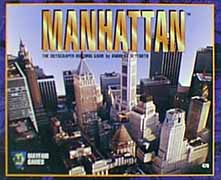
Manhattan is an enjoyable and simple game. Taking only 15 minutes to learn and 20 minutes to play, this game is frequently played as a "filler" game, "waiting-to-play" game, or "too-drunk-to-think" game. It makes a great game for non-gamers and new-comers, but it is enjoyable enough to play repeatedly.

|
| Courtesy of Funagain Games |
After each round of six building pieces, the board is scored. Each building scores one point, each neighborhood in which you have a majority of buildings scores 2 points, and the tallest building on the board scores 3 points. The current score is kept on a nice, linear point track on the board next to the neighborhoods. After 4 rounds the game is over and the highest score wins.
The strategy and decision making in the game is somewhat limited. Each turn, your moves are limited to the number of cards in your hand. Most tactical play decisions are in deciding whether you want to attack another player by fighting for buildings or remain neutral by playing in an open city block. When you are on the attack, most players attack the leader to try to "reel in the king." Decision making can be expanded by expanding the number of cards in hand to 5 or 6.
One strategy is to maximize your net points scored by always attacking other player's buildings: this gains you a point for the building and forces another to lose a building for a net gain of 2 points. Winning a majority at someone else's expense nets 4 points: you gain 2 and someone losses 2.
Using these mechanistic strategy rules, some players find this game boring. Agreed, but to counter this argument, I turn my strategy to timing issues. Given two equal scoring opportunites, will it be better to attack so-and-so first or last? I also pay attention to giving my most devastating attacks at the end of a round. Perhaps the person will forget their attacker after the moaning and groaning of the scoring. It is wise to pay attention to an opponent's placements to discern whether the person can answer an attack. Usually if you attack in a space where an opponent has just played, they are less likely to have a second card of the same type, and therefore, they cannot answer your attack. Despite knowledge of these more sophisticated strategies, often one's plans are governed by the random availability of moves. Perhaps a "diceless" game of Manhattan, in which all the cards are discarded and any block is available for attack, would be the ultimate thinking man's version of this game.
The game works best with 4 players because this increases the number of attack options for each player. Unfortunately, if you are playing with long-thinking strategists, this also leads to the longest gap between moves and can be the most boring. A game of Manhattan between 2 players is least interesting because it turns into a game of tit for tat. On the other hand, you will be moving most frequently in a 2 player game.
Perhaps the most appealling part of the game is watching the three dimensional city rise from the board. Spatially, it is a very pretty game, especially near the end when the buildings climb toward the heavens. Psychologically, the battle for the tallest building is always more heated than it is worth. Despite garnering only 3 points, I have seen many games with all-out free-for-alls for the tallest building, to the point where this building was twice as high as the next highest building. Good luck rebuilding this one if the dog bumps the table and tips it over.
Because of the simplicity of the game, many have invented game variants. As mentioned, one can change the number of cards in hand. More cards in hand will increase movement possibilities and tactical possibilites. Fewer cards in hand will increase the random luck element of the game. With 24 building pieces, one can also change the number of scoring rounds or the number of building pieces per round: 2, 3, 4, 6, 8 and 12 all divide nicely into the magic number 24. Others like to play the Godzilla or Baby-Godzilla variants, in which a playing card can move the monster which destroys the entire building, the top floor, or the bottom floor. Tinkering is fun with this game.
So in conclusion, there are lots of enjoyment in this game. Yes perhaps a little bit low on strategy and decision making, but an enjoyable game none-the-less.